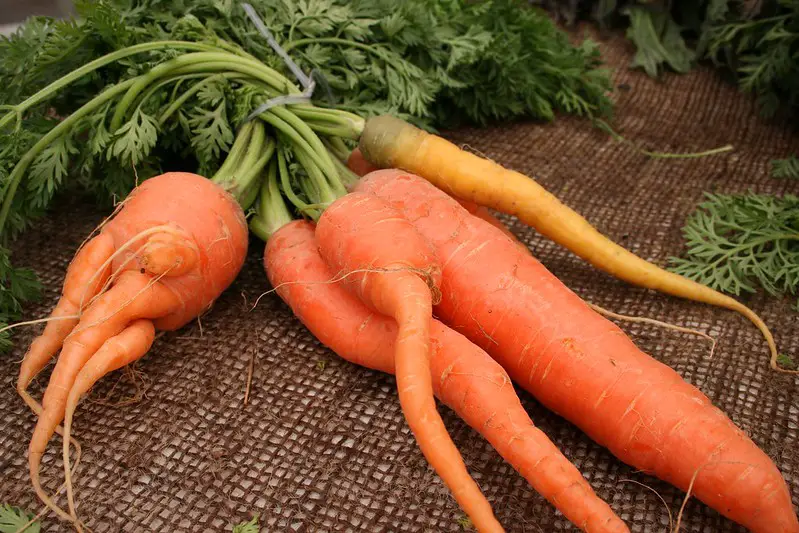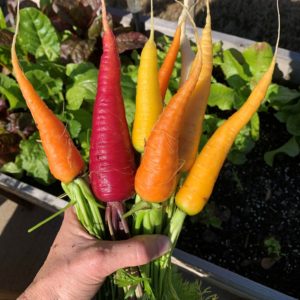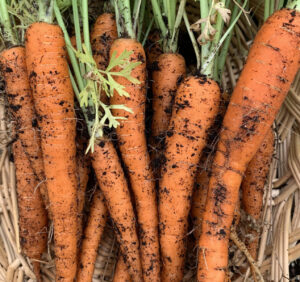Lush, green carrots tops are not always a sign that the root is developing properly beneath the soil. On the contrary, while the tops look healthy and vibrant, the roots can be stunted, forked, twisted, or otherwise deformed. It can be disappointing and frustrating to wait 75 to 80 days to harvest carrots, only to find that they look nothing like we had imagined.
What causes carrots to be deformed, and what can we do about it? Here are the top 8 reasons why carrots are irregularly shaped and what you can do to prevent it from happening.
This article contains affiliate links. If you make a purchase using one of these links, I will receive a very small commission at no additional cost to you, and it will help me maintain this website. Rest assured, I only recommend products I actually like!
1. Obstructions in the Soil
Carrots are super sensitive when it comes to soil conditions. As root vegetables, they will take the path of least resistance, meaning that if the growing tip runs into an obstruction, like a rock, dirt clod, woodchips, other roots, including weeds, it will change direction. This re-direction will result in wacky-looking carrots instead of nice straight ones.
To remedy the problem, before planting, remove objects from the growing area that might obstruct the carrot’s downward growth. It can be very helpful to use a soil sifter to filter the dirt.
2. Soil Conditions
Carrots do best in loose soil because it is easier for the growing tip to penetrate. Thus, when the soil contains clay or is compacted, it will impede the growing tip’s progress resulting in stunted or stubby carrots.
Clay soil is comprised primarily of minerals with little organic matter, making it dense, sticky, and unable to drain water effectively. To improve clay soil, add compost, which is rich in organic matter, into the top several inches of the soil. To facilitate mixing, make sure both the soil and compost are dry.
If your soil is compacted, you can use a broad fork to loosen it, especially if you are doing the no-till method. The broad fork will penetrate and loosen the soil with minimal disturbance to microorganisms. Or, if you use more traditional gardening methods, you can use a tiller to break up the compaction. Either way, you will need to loosen the soil to at least the same depth as the length of the variety of carrots you are going to plant. If you want, you can also add a few inches of compost. Be mindful, however, where you step so that you will not re-compact the soil you just loosened.

3. Too Much Nitrogen
Carrots do not require a lot of nitrogen. That is because nitrogen primarily promotes leaf growth, whereas phosphorus and potassium are more important to root and fruit development. Too much nitrogen will cause the carrot tops to be big and beautiful, but the roots will be small. It can also cause the root to have multiple shoots or branches or be covered in root hairs. It’s not that carrots do not need nitrogen, it’s just that they require a lower nitrogen to phosphorus and potassium ratio than other plants.
Before planting, you may want to test the nitrogen, phosphorus, and potassium levels of the soil with a test kit. If the test result shows inadequate phosphorus or potassium levels, you can amend the soil with bone meal (not blood meal, which adds nitrogen). During the growing season, use a fertilizer that is lower in nitrogen and higher in phosphorus like the one I use.
4. Carrots Are Too Crowded
Another reason carrots are deformed is because they were grown too close together. If not spaced an appropriate distance apart, the roots will compete for space, water, and nutrients. Thus, you will need to thin carrots seedlings to a distance of about 1 plant per 3 inches (8 cm). Otherwise, they can crowd each other out and cause root malformation. Cut the unwanted seedlings at the soil level instead of pulling them up, which may disturb the root of neighboring seedlings.
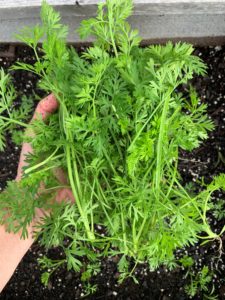
Even though you had to thin out the seedlings, all is not lost. Compost the unwanted seedlings or feed them to chickens, rabbits, goats, etc., if you have them. Some like to turn the sprouts into pesto or add them to vegetable stock or smoothies.
Resist the temptation to skip the thinning out process or squeeze in more than one carrot per 3 inches (8 cm). You will be glad you did!
5. Root Knot Nematodes
Root knot nematodes are microscopic worms that feed on roots. They cause galls or knots on carrots, as well as hairy roots. Carrot tops that look stunted or wilted may be a sign that the parasite is lurking beneath the soil, but they often go undetected until harvest time.
Unfortunately, there is no treatment for carrots that have root knot nematodes. Once they are detected, you will have to pull up the infected plants and throw them out. Do not compost them, as most compost piles do not maintain high enough heat to kill the parasites. Clean any garden tools or equipment that has come into contact with the infected soil so that the nematodes won’t be transferred to other areas.
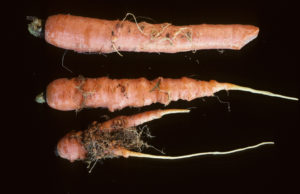
Do not replant carrots or other nematode-loving crops in the area. Instead, plant asparagus, corn, or something from the brassicas family (like broccoli, cabbage, Brussels sprouts, kale, cauliflower, mustard greens, etc.).
A heavy planting of marigolds can help keep nematode populations under control, as can the addition of compost, which will add beneficial microorganisms to the soil. Learn more methods for effectively eliminating destructive root knot nematodes from your garden in this helpful article.
6. Aster Yellows Phytoplasma
Yet, another reason carrots are deformed is aster yellows phytoplasma, a disease that is transmitted by the aster leafhopper. The disease causes leaves to curl or turn yellow while the veins remain green. The roots will be deformed, hairy, and bitter tasting.
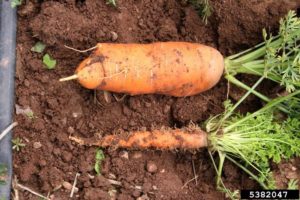
To manage the disease, remove infected plants to prevent its spread. Do not compost them as the heat will most likely not be high enough to kill the pathogen. Also, remove weeds, especially broadleaf weeds like dandelions or plantains, which are the most common host plant. You can also use a row cover to protect crops from the disease-carrying leafhoppers.
7. Watering Issues
Like tomatoes, inconsistent watering can affect carrots. For example, dry soil that receives heavy watering by irrigation or rain may cause too much of a fluctuation in moisture levels, causing the carrots to crack or split. Do your best to water when the soil is beginning to dry out, but be careful not to overwater.
8. Transplanted Instead of Direct Sown
Some seeds can be planted into seed pots and then later transplanted into the ground, but not carrots. They are very sensitive to root disturbance. Therefore, it is best to direct sow the seeds. Otherwise, the roots will be most likely be misshapen or stunted.
Carrots are one of the most enjoyable and rewarding crops to grow. With a little planning and care, you can successfully grow beautiful carrots. You can learn more about how to grow carrots in this helpful article.
Thank you for reading this article! If you found it helpful, please consider sharing it with others via email and social media!
